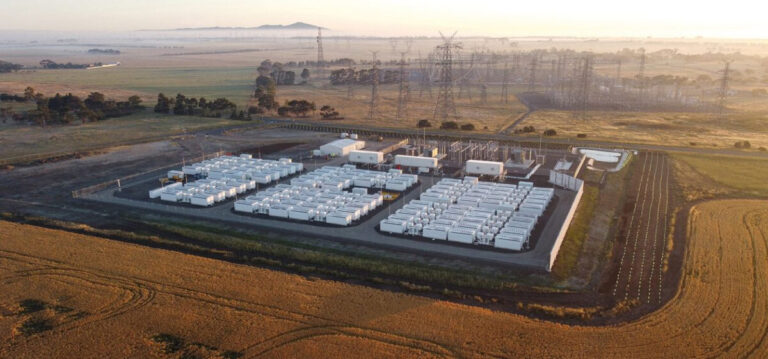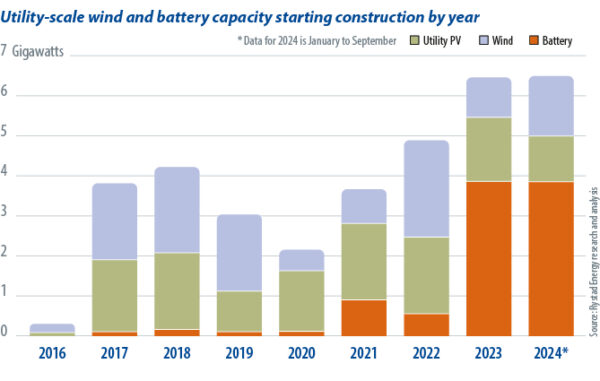Printed edition 24/10 from pv magazine
The guys in the back of the bus were engaged in a debate about the prospects for Australian energy storage. In June 2024, during a tour of Shanghai organized by Australia’s Smart Energy Council, Tim Buckley, boss of think tank Climate Energy Finance, and renewable energy financier Oliver Yates were deep in conversation.
Yates was convinced that batteries were about to dominate all forms of energy storage, while Buckley mused that this could be the result of their visits to battery maker CATL and power electronics giant Sungrow. Yates, the first CEO of the federally owned green bank Clean Energy Finance Corporation, has financed energy storage facilities. His prediction that batteries would surpass gas-fired power stations and offshore wind energy in providing evening power was therefore remarkable.
Buckley agreed. “There is such a dramatic pace of technological advancement in batteries, coupled with scale, that whatever advantages other technologies had five to six years ago in meeting the evening peak demand are gone,” he said. “Batteries will do much more heavy lifting than was thought a few years ago.”
High volume
The volume of battery energy storage capacity connected to the grid, under construction and reaching the final investment decision confirms this statement. Business intelligence firm Rystad Energy has said that nearly 4 GW of large-scale battery energy storage systems (BESS) have come under construction in the first nine months of 2024. That is equal to the full annual figure for 2023.
BloombergNEF has confirmed the rapid buildout of large batteries, recording 7.8 GW of utility-scale BESS currently under construction in Australia. It is said that installed large battery capacity will grow from 1.7 GW today to 18.5 GW by 2035.
The picture is echoed in mature renewable energy markets in California and Texas, where large-scale BESS has consolidated electricity supplies and smoothed wholesale market price spikes.
Down Under, favorable economics for co-location with solar and wind energy sites, the attractiveness of long-term energy storage, supportive policies and falling battery pack prices all support large-scale BESS growth. With the government targeting an 82% renewable energy mix by 2030, large batteries will be essential. Yates’ prediction seems likely to be correct.
Long(er) duration
Australia’s large batteries are increasing in size, with storage capacities increasing from one hour to two, four and even eight hours, thanks to changes in battery revenue streams. Sites have moved from generating revenue from short-term markets for grid reinforcement ancillary frequency control services (FCAS) to energy arbitrage – storing electricity when prices for sale during peak periods are low.
Energy economist Bruce Mountain confirmed that big batteries are attracting investors in Australia and capacity is growing.
“As a percentage of our peak electricity demand, we are tied with California and Texas in the rate of large-scale storage, and we are seeing a similar increase in energy-to-energy capabilities as in those regions. Berg said. The director of the Victoria Energy Policy Center added that while these are positive developments, the volumes are not yet high enough to boost the ever-decreasing wholesale electricity prices during the day.
Leonard Quong, BloombergNEF’s head of Australian energy transition and trade research, outlines the development of the large-scale BESS market segment, from FCAS to arbitrage, and said a “tsunami of rooftop solar” and utility-scale solar “will drive up the price of energy has reformed. dynamics in Australia.” As a result, he claimed, the arbitrage opportunities for large battery storage systems have become attractive.
“Throughout 2023, wholesale prices on the East Coast were below zero about 9% of the time,” Quong said. “In some states it was more than 25% of the time. So more and more batteries are being built to participate in the wholesale market and arbitrage prices. As a result, we are seeing larger batteries.”
Quong added that the battery arbitrage business model, while attractive, is “extremely complex and dynamic,” meaning supportive policy measures remain important.
Rystad Energy’s figures also confirm a trend of increased attractiveness for arbitrage opportunities. David Dixon, a Sydney-based renewable energy analyst at Rystad, said most Australian states recorded more than 1,000 hours of negative electricity prices in 2023, “with South Australia at 2,165 hours.”
Co-location the norm
The increasing number of negative electricity prices is also the driving force behind the co-location of large BESS with PV and wind energy. As Australia’s rooftop PV installations appear to be winding down at a volume of around 3 GW per year, and installation sizes for each system are reaching 9 kWp, Quong’s rooftop ‘tsunami’ has become an enveloping wave. Australia’s world-leading rooftop segment is cause for celebration, but has created significant headwinds for large-scale renewables.
CIS supply for large batteries
In May 2024, the Australian Government tendered 6 GW of renewables and energy storage capacity under its Capacity Investment Scheme (CIS). On September 4, 2024, it was announced that six large four-hour batteries in South Australia and Victoria, with a combined capacity of 1,081 MW, had been successful – far exceeding initial expectations. The largest site, the 350MW Wooreen storage system, is adjacent to the 400MW Jeeralang gas-fired power station in Hazelwood North, Victoria.
Think tank boss Buckley said that during a recent discussion with bankers from major institutions who were actively looking for renewable energy projects to lend to, he heard they could not find suitable developments.
“Ultimately there is the price volatility and the lack of long-term PPAs [power purchase agreements] have created commercial-scale sustainable energy projects [in Australia] virtually unbankable,” Buckley said. “Why would anyone build utility solar if your market is being eaten up by rooftop solar?”
Fortunately, Buckley says, rapidly falling battery prices make co-location with energy storage attractive.
“The dramatic cost savings, 50% in the last 12 to 18 months for batteries, and [PV] module prices falling by 60% has changed the game,” he said.
Coal closures
Australia remains heavily dependent on aging coal-fired power stations. In the most likely scenario of the country’s latest Integrated System Plan, the Australian Energy Market Operator predicts the lights at the last coal-fired site will go out in 2038.
Mountain from the Victoria Energy Policy Center said when coal runs out – and still provides 55% of generation year-round – a lot of generation capacity will have to be replaced in the middle of the day.
“The nature of coal generation is that it is inflexible and has significant start-up costs, meaning negative prices are bid throughout the day,” Mountain said. “People talk about an abundance of solar energy, but we are still miles away from an abundance of solar energy. We still need large quantities of it and it is the cheapest per kilowatt hour.”
Given the attractive long-term dynamics, BESS investors see “an infinite horizon, relative to a starting point for new battery developments,” Mountain added, making such projects a relatively safe bet.
Sites of former coal-fired power stations are already attracting large-scale battery projects because of their electricity infrastructure. AGL is building the 500 MW/1 GWh Liddell Battery Project in New South Wales, in May 2024 the Queensland state-owned utility announced it was doubling the size of its Stanwell Clean Energy Hub battery to 300 MW/1.2 GWh, and The Collie Battery in Western Australia is planned to eventually have a size of 1 GW/4 GWh, including a first phase of 219 MW/877 MWh.
“The Collie’s large battery will be crucial [in Western Australia] because people will suddenly realize that these big batteries work and work very well,” says Ray Wills, an academic at Perth consultancy Future Smart Strategies. “This experience will change the way regulators see what is possible.”
This content is copyrighted and may not be reused. If you would like to collaborate with us and reuse some of our content, please contact: editors@pv-magazine.com.
Popular content




